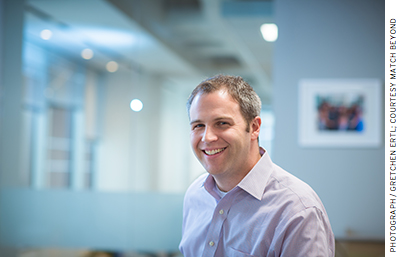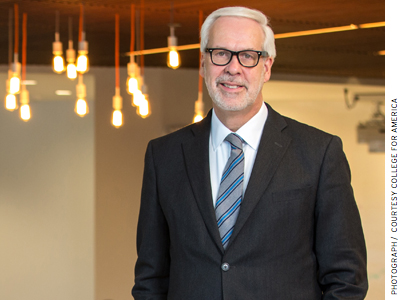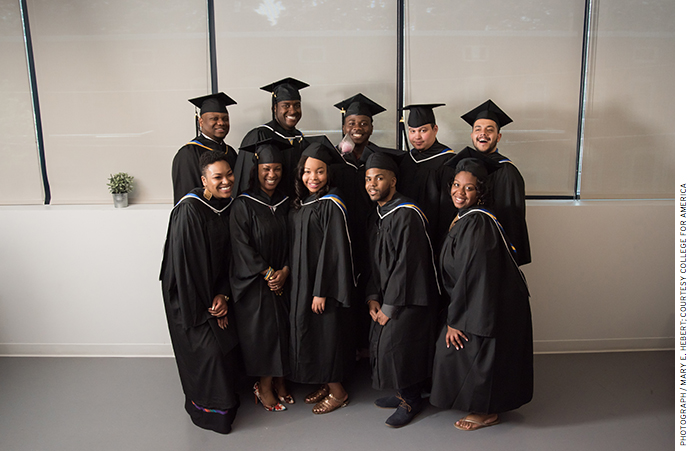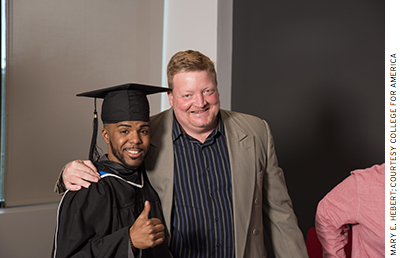
The daughter of Jamaican immigrants who moved to Boston when she was three, Tena Fenton grew up in a city rich with universities and colleges that nonetheless seemed out of reach to her and others like her.
Then, in middle school, she took a field trip to one of those places—Northeastern University—and resolved to beat the odds.
“Immediately, I wanted to go there,” Fenton said.
And she did. Drawn to the selective campus by its high job-placement rate, Fenton was accepted to Northeastern and enrolled there in 2005, with plans to major in psychology.
By the end of her first year, she was forced to drop out.
“It broke my heart that I had to leave,” said Fenton. But in spite of help from scholarships, she and her family had run out of money to cover the then $26,990 annual cost of tuition at the private, nonprofit university.
Fenton went to work in a succession of jobs, always suspecting that her lack of a higher education thwarted any prospects for advancement. When time allowed, she took courses at a community college. She still had no degree when, 10 years later, she was laid off from a job as a case manager helping troubled youth, along with two co-workers who had also never finished college.
“That did a number on me,” she said. “I hit a ceiling, mentally. My mind told me it was because I didn’t have a degree.”
Then Fenton discovered Match Beyond, an innovative Boston nonprofit that helps young people complete their college education in a way that is both efficient and affordable. “To hear about a college program that allows you to go at your own pace and how inexpensive it was—it was too good to be true. There had to be a catch,” she said.
Fenton signed on, and five months later, she had an associate’s degree.
“I learned more in those five months than I honestly feel I learned in my year at Northeastern,” she said. “I’m not criticizing Northeastern, but these were things I could use in my life.”
Pioneering Approach
Match Beyond, launched in late 2013, offers accelerated degree programs through a pioneering approach that combines online education—provided by a partner, Southern New Hampshire University—with intensive coaching and support, including job-placement counseling. Boston’s tiny Match Charter High School started the program for its own graduates—93 percent of whom were black or Hispanic—who were running into some of the same obstacles that Fenton faced. The high school managed to get almost all of its graduates into two- or four-year colleges, but only about half of them were finishing.
That success rate far exceeded the national average for low-income students, but Match High wasn’t satisfied with it, said Bob Hill, a teacher at the school and adviser to its freshly produced alumni, who at the time numbered around 200. “It was painful to see 46 percent of the students not succeeding in college.”
So in 2011 Hill set out on a two-year quest to find out why so many of these students weren’t making it through college, personally visiting many of them on campus.
“It’s not that they weren’t doing well,” he said. “They were surviving and in some cases thriving. But you’re very much isolated and on your own in college, and I don’t think learning works that way in life.”
Besides, he said, his students faced a unique set of challenges. Some had to work to pay their tuition, or had children or other family obligations. They simply did not have as much time for studying as traditional college students did. Nor did they have the resources, mindset, or experience. Most were first-generation college-goers, and, lacking family role models, needed moral support and encouragement to stay the course.
Yet, with all of these obstacles, Match’s graduates “had to adjust to the [college] model rather than the model adjusting to their complicated lives,” Hill said.

He and his colleagues decided to transform that model, at least for Match’s graduates.
“We had put a lot of time and effort into getting these kids through high school, with the idea of [their] finishing college,” said Mike Larsson, now chief operating officer of Match Beyond. “We took that very seriously. Students came to our school with the idea that they’d succeed. We knew every single kid that walked through the door of that place. Loved them. Cared about them.”
The Match teachers and administrators realized their caring couldn’t stop on graduation day if their students were going to fulfill those hopes of success. So Match took a new step—one that other high schools in the country have also been quietly pursuing: it took responsibility not merely for getting its students high school diplomas but for coaching them through college.
“This is something the colleges should do,” said Hill, but don’t. The chance of a low-income, first-generation student earning a bachelor’s degree within six years of high school graduation is less than 1 in 10—and dropping, according to the Pell Institute for the Study of Opportunity in Higher Education and the University of Pennsylvania Alliance for Higher Education and Democracy. That compares to a 75 percent success rate in six years for children from the wealthiest families.
Match Beyond
The Match High leaders put a new twist on the “no excuses” policies that many charter schools employ: instead of allowing no excuses on the part of their students, Larsson said, they chose to make no excuses for themselves.
To get the new effort started, the charter school approached a number of traditional colleges and universities about teaming up on new ways to help more Match graduates get their degrees. Not one wanted to partner with them. Then they stumbled onto College for America, or CFA, a spinoff of the nonprofit Southern New Hampshire University (SNHU).

Ten years ago, SNHU was a small accounting college struggling with declining enrollment and money woes. But the school turned itself around by ramping up its online division that was geared toward working adults, renaming the program College for America. Today, while SNHU still serves 3,000 traditional-age students on its brick-and-mortar campuses, it has enrolled some 60,000 more online, and 5,000 through College for America.
Although conceived for adults whose employers would cover the tuition costs, CFA has proved a good fit for recent high-school grads of limited means. It’s comparatively affordable—originally $2,500 a year (now $3,000)—and flexible, providing all coursework online.
College for America also got a waiver from the U.S. Department of Education, releasing it from an obscure requirement that college progress be measured by the number of credit hours students complete. The online program needed the waiver, the first of its kind, so its students would be eligible to apply for federal Pell Grants: that’s because CFA doesn’t use credit hours, or even traditional college “courses.” Instead, CFA asks students to demonstrate mastery of 120 “competencies” toward 20 goals on any of nine career paths. For a bachelor’s degree in management, for instance, competencies include “evaluat[ing] risks and benefits of international transactions” and “explain[ing] the impact of social, cultural, legal, and political factors on international business operations.” After successfully completing a number of projects, students submit their work to faculty for review, receiving not a letter grade but either a “yes” or a “not yet.” If it’s the former, students move on to the next competency; if the latter, they go back and keep trying. But the longer they take, the more tuition they end up paying, so there’s little incentive to procrastinate.
“Probably the single most important thing you can say about this model is that we’ve reversed the relationship between learning and time,” said Southern New Hampshire president Paul LeBlanc. “The credit hour is very good at telling us how long someone sat in a chair. It’s not very good at telling us what they’ve learned.” And if life imposes, and students can’t show up for class, they don’t miss out on the material they would in a conventional course, because they proceed at their own pace.
Nor, for that matter, are they limited in how much they can accelerate their progress. “With College for America, if you want to do 36 hours this weekend, you can do it,” said Match Beyond’s Larsson.
In College for America, Match High had found a seemingly ideal infrastructure for its new outreach effort to recent grads. Students would take CFA’s online courses, and Match would offer the coaching, mentoring, and peer support that would help them persevere. Match enrolled its first nine graduates in College for America in late 2013, with Hill serving as coach to help them through. Hill and his colleague Larsson liken the coaching role to that of a personal fitness trainer—part expert guide, part motivator.
The students and their coach met regularly at a Panera Bread shop with free Wi-Fi, at a shopping center in South Boston. “We ate a lot of bread bowls,” Hill quipped. “A lot of bread bowls.”
Eight students from that first group have now earned associate’s degrees; the ninth, said Larsson, is close to getting hers.
Match Beyond has since evolved to serve not only Match High alumni but also outside students such as Tena Fenton.
Students in the program range in age from 19 to 40, but most are 20- to 24-year-olds who tried conventional college but didn’t finish. They also vary in their economic circumstances. Some have decent jobs and incomes, while others struggle financially. What most have in common is that they can’t advance in their jobs, or find better ones, without postsecondary education. Match Beyond’s mission, it says, is to help students earn degrees that lead to middle-class employment.
In addition to College for America’s $3,000 annual tuition, students pay $2,500 to Match Beyond for the coaching and for study space in a high-rise in Boston’s Financial District, where many come on weekends or after work, and where there’s always a supply of sandwiches, salads, pizzas, or calzones. (“If you offer dinner,” said Larsson, “it’s easier to get people to come.”)
Students could enroll at CFA on their own and skip the Match Beyond tuition—but the wraparound services and support the program offers seem to make a crucial difference.
Other than the strips of paper Scotch-taped to the glass that name one conference room for the educator and civil-rights leader Mary McLeod Bethune and the other for W. E. B. Du Bois, the Match Beyond space is a fairly sterile office. The building in which it’s located, formerly the site of a mutual insurance company, has been transformed into startup space for entrepreneurs, IT specialists, architects, and a number of nonprofit organizations. Like Match Beyond, some of them are focused on helping first-generation, low-income, and other underrepresented students navigate the higher-education maze.
The $2,500 that students pay to Match Beyond is billed through College for America and is therefore also eligible for Pell Grants. Some students pay their own way, while others are sponsored by their employers. Tena Fenton used her severance package from work. The cost, though small compared to traditional college tuition, provides an incentive that might be lacking if Match Beyond simply provided free professional or peer coaching. As the program leaders put it: “You hired us to believe in you.”
Match Beyond enrolls about 130 students today, with three coaches, one of whom is now Tena Fenton. Another coach just got his bachelor’s degree at the age of 36. The advisers receive daily email updates from CFA on their advisees’ progress, and meet weekly in the Mary McLeod Bethune conference room to discuss it.
Fenton contrasts this personal approach with the practices of many conventional colleges, where “you don’t even know that a student is failing until the end of the semester,” she said. Added Larsson: “When we were trying to coach our alumni through college, we struggled because we had a hard time knowing what was going on with them.” Now, he said, “we know if a student starts to go off track very quickly…. We know when things go haywire. We know if they have trouble uploading a video or if they’re not getting work done because they don’t have space to work at home.”
Her students, Fenton said, “come from all walks of life. Some come with a lot that’s hidden about what’s going on in their lives, and it takes some time to get their trust. Some, I feel like they’re my little brother or sister. When they come in to work, I make them get up and eat.”

Responding to Change
This small-scale strategy exposes the need for flexibility and personal attention required by a demographic that is about to descend in huge numbers on universities and colleges—low-income racial and ethnic minorities whose parents don’t have college educations.
Other charter high schools and community organizations nationwide are using approaches similar to Match Beyond’s. Named after bicyclists who work together in a team, PelotonU in Austin, Texas, serves older adults, also with online courses, and adds a strong element of peer pressure and support. The program starts groups of students at College for America at the same time and requires them to spend 12 hours a week with classmates and coaches in a study space. Students also post which projects they’re working on so they can help each other out.
In Los Angeles, the Da Vinci charter schools offer the Da Vinci Extension program, or DVX. Participating students stay in school for a 13th year, during which they start earning college credit without charge while also working in paid and unpaid internships. And at Rhode Island’s state-operated Metropolitan Regional Career and Technical Center, or Met School, students enroll concurrently in college courses for free as early as the 10th grade.
Like Match Beyond, these programs are affordable (or free) and flexible, and typically combine in-person support and coaching with online education. Even those that offer the option to take courses in a brick-and-mortar classroom give students the kind of personal attention advocates contend few universities and colleges provide.
“I’m sure colleges could give good reasons why they are the way they are. But good reasons or not, the impact on urban kids is devastating,” said Michael Druckman, executive chair of Schools That Can, a network of 177 public, charter, and private schools in 15 cities serving more than 70,000 students, including those at the Da Vinci Schools.
It speaks to a shortcoming of American higher education that the college failure rate of low-income students is so great, high schools have had to undertake the job of coaching them through the process. This situation is not only a sad outgrowth of America’s socioeconomic divide but also a huge problem for universities and employers, considering that birthrates are flat or down among the affluent white suburban families that have traditionally sent their kids to college. Over half of primary- and secondary-school students hurtling toward college age nationwide are poor enough to qualify for free and reduced-price lunches, the Southern Education Foundation reports.
“More than half [our] kids are from a population from which less than 10 percent graduate college,” Druckman said. “That summarizes the problem.” Or, as Tracy Money, vice president of strategy and planning at the Met School’s College Unbound program, puts it: “Colleges haven’t changed a lot in the last hundred years. But students have changed a whole lot.”
Studying the Model
In all its variations, the new approach is poised to become a disruptive force in higher education for low-income racial and ethnic minorities. Yet there are lingering questions about the model, which researchers are only now beginning to study. One of these researchers is Heather Lattimer, associate professor of learning and teaching at the University of San Diego, who is working under a grant from the Los Angeles–based ECMC Foundation.
Herself a former teacher in urban middle and high schools, Lattimer plans to examine whether employers see a College for America degree as a viable alternative to one from a conventional college. (Since College for America serves mainly people who are already employed, the data on this question so far come from a CFA survey of participating employers, conducted in June 2016. One hundred percent said they were more likely to retain those students and 43 percent said the students were promoted more often. Twenty percent of the students themselves reported having gotten a raise tied to a promotion or new position.)
Lattimer also wants to determine if coaching can increase the low completion rates of online higher-education courses, especially for students who don’t have great preparation or self-discipline.
“We know that online programs generally don’t work for students under 30,” she said. “They work for students who are older and in the workforce and have structure in their lives,” and who know firsthand that a degree can often bring concrete rewards such as a promotion or a raise.
Lattimer also wonders whether students congregating over Buffalo chicken calzones in a Boston office building get an experience similar to those of their counterparts on brick-and-mortar campuses—“that cross-pollination of ideas,” as she described it, “that many of us got who went to traditional colleges and universities.” (Responded Hill: “You can argue that there’s some amorphous experience students get being on a college campus, but I’ll speak for myself: it involved more beers than learning. It’s become a middle-class rite of passage, and if your parents can pay for it, great.”)

Another question concerns the quality of the projects on which College for America is built. Lattimer said that from what she has seen of them, they appear to be “thoughtfully designed.” But she wants to hear from the students themselves about whether the CFA coursework “pushes them to think more deeply.” LeBlanc, at Southern New Hampshire, said he’s heard critics bash the projects for not encompassing the liberal arts, which they contend teach critical thinking and communication skills.
“It’s a knock people want to throw at us when they don’t like what we’re doing,” said LeBlanc, a former English professor who points out that his institution is reviewed by the same association that accredits Harvard and Yale.
“It’s liberal arts,” he said. “We have a project around history. Our students read Michael Sandel on torture. They have to talk about ethics. They understand what stoicism is, what existentialism is.”
There are some programs that can offer side-by-side comparisons of how low-income students fare under this new model versus in traditional college classrooms. One is the Met School, where some high-school students take conventional courses at a neighboring community college and others are enrolled in online classes through CFA. Another is Da Vinci, where students in the 13th-year DVX program can take courses not only from College for America but also in person, through the UCLA Extension. At UCLA, they get the additional support of a welcome lunch, a tour, and their own mini-graduation ceremony, in addition to space and coaches at Da Vinci. As long as students remain enrolled in high school, the cost is covered by the state. (“Just [being] on campus allows them to feel like they belong, and that’s not an element this demographic gets to have very often,” said Van Anderson, director of custom programs for the UCLA Extension. “It’s huge for them.”)
For Met kids, however, the College for America approach appears to have an edge.
“The advantage is that they don’t have to leave the [high school] campus,” Money said. “They can do the program here with adviser support.” CFA students wind up with 15 college credits, on average, before completing high school, versus 4.5 credits for students who go the standard community-college route; of nine students in the CFA pilot program, six are on track to graduate high school next year already having earned associate’s degrees.
The flexibility of College for America is a big plus, said Money. Students like the “yes” and “not yet” feedback, as opposed to having one shot at a grade. As for keeping the price low, Rhode Island covers the cost of dual-enrollment courses provided by in-state institutions such as the community college. Students in the CFA group can use Pell money under yet another U.S. Department of Education experiment that’s providing some $20 million this year to as many as 10,000 low-income students nationwide to pay for college-level work while they are still in high school.
For students who hope to move to a conventional university or college after studying through College for America, not all courses will transfer automatically as general education credits, Money said; some are counted only as electives. But the results are so far promising enough that the Met is launching an alumni program similar to Match Beyond’s for its graduates who have yet to finish college.
Obstacles and Opportunities
Personal attention is the key to this approach, and that requires programs to stay small, raising the question: how much can a few programs, each enrolling only 100 or so students, really do to close the widening degree gap?
“If you launch thinking, ‘Let’s bring in 10,000 kids,’ then you’ve failed before you started,” said Kim Merritt, director of DVX. “The whole idea behind this model is that these kids come from our community, they trust us, they know us.”
Advocates say scaling up this concept does not mean expanding existing programs but adding many, many more.
“The way we envision this thing growing is not by Match going out and having tens of thousands of students, but by other organizations like ours in other cities doing this,” said Larsson.
Some conventional universities and colleges are taking note. Schools That Can is in talks with several to find ways to provide low-income students with online and classroom courses plus in-person coaching, possibly by graduate assistants. And the College for America model being tried at the Da Vinci Schools is likely to expand to three or four other cities by next year, Druckman said.
“We want to be very careful,” he said, because online learning has “come under a lot of controversy. There have been some bad players, of which College for America is definitely not one. We have to be careful not to have any failures, and the way to do that is to go slowly.”
Extension schools can also be a bridge, said Wayne Smutz, dean of continuing education at UCLA, which is trying to raise scholarship money for this purpose and is designing pop-up classrooms to operate in neighborhoods where low-income students live.
“It seems to me a combination of using support people and using technology is something we could scale, but we have a lot to learn before we get to that point,” Smutz said. “We do have to get success in these smaller efforts so we know what we’re doing and that it makes a difference.”
As for the cost of programs that require so much personal attention, Money said, traditional higher education will have to reexamine its use of resources and “figure out where it can cut. Is it middle management positions? Is it your advisers taking on some of those roles?” Even at her high school, she said, teachers and advisers shoulder other jobs, such as helping with financial aid and registration. “It starts with looking at what you’re spending money on.”
However such challenges are addressed, one thing is certain: colleges and universities will have to start adapting to the needs of a dramatically different student population. “We cannot continue to survive as higher-education institutions doing things the same way,” said Lattimer. “We need to change, or it’s going to be a tsunami that overtakes us.”
Jon Marcus is higher-education editor at the Hechinger Report, a foundation-supported nonprofit based at Columbia University, and North America correspondent for the (London) Times Higher Education magazine. He lives in Boston.
This article appeared in the Spring 2017 issue of Education Next. Suggested citation format:
Marcus, J. (2017). A New Path to a College Degree: Match Beyond helps low-income students succeed. Education Next, 17(2), 44-51.


